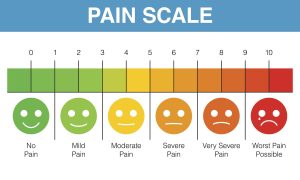 A pain scale measures and communicates the intensity of pain experienced by an individual.
A pain scale measures and communicates the intensity of pain experienced by an individual.
It is commonly used in medical settings to assess and monitor a patient’s level of pain.
One of the most widely used pain scales is the Numerical Rating Scale (NRS), which ranges from 0 to 10.
On this scale, 0 represents no pain, while 10 represents the worst possible pain imaginable.
The Verbal Rating Scale (VRS), which uses descriptive words to describe the intensity of pain, such as “no pain,” “mild pain,” “moderate pain,” “severe pain,” or “worst possible pain.”
The Visual Analog Scale (VAS): consists of a horizontal or vertical line, usually 10 centimeters long, with anchors at each end representing “no pain” and “worst possible pain.”
Patients are asked to mark a point on the line that best represents their current level of pain.
Wong-Baker FACES Pain Rating Scale: This scale is commonly used for children and individuals with cognitive or communication difficulties.
It features a series of cartoon faces ranging from a smiling face meaning no pain to a crying face reflecting worst possible pain.
Self-Report: Pain scales rely on self-report from the patient, as pain is a subjective experience that cannot be objectively measured.
Pain scales have limitations: difficulty in accurately quantifying subjective experiences, cultural or linguistic barriers, and potential for bias or misinterpretation.
Pain scales are important tools in clinical practice, as they help facilitate communication between patients and healthcare providers, enabling better pain management and improved patient care.
